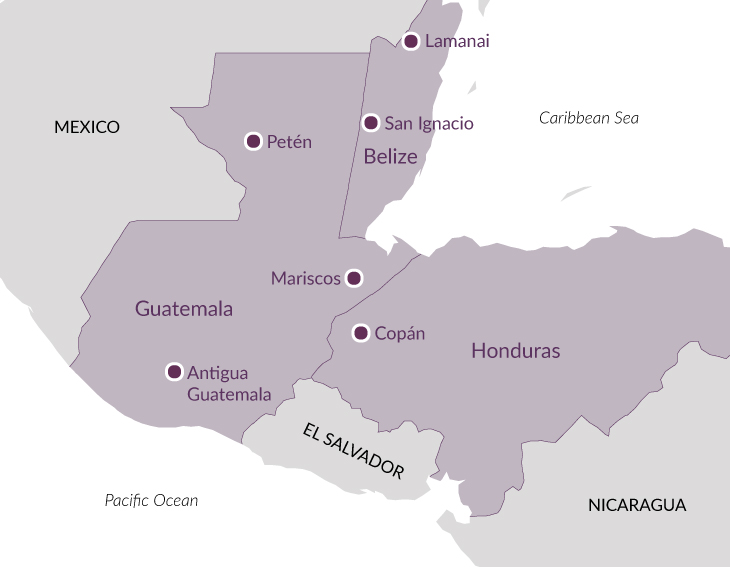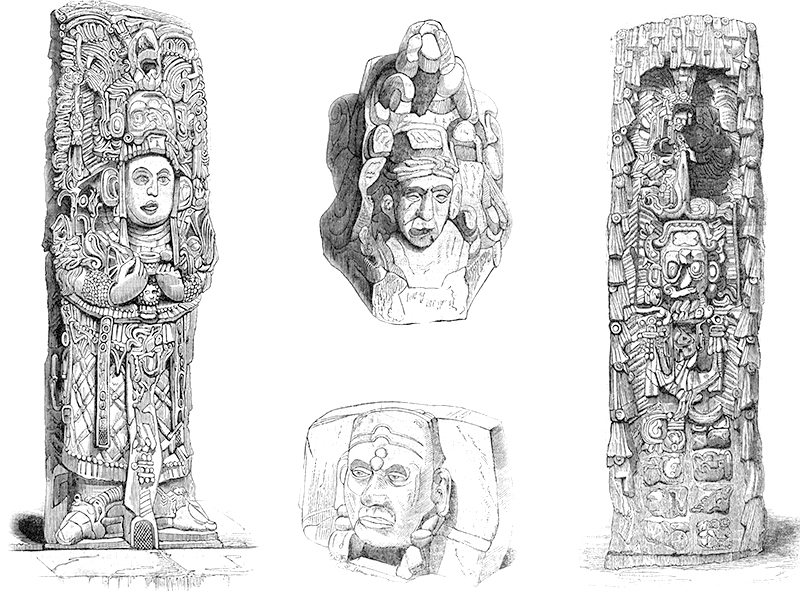Overview
Ever since explorers revealed the existence of their jungle-clad ruins in the 1840s, the ‘lost’ civilization of the Maya has been a cause of astonishment and speculation. For while Europe was struggling through the ‘Dark Ages’, Maya peoples were enjoying the apogée of their civilization in seemingly the most unlikely of places – the rainforests of Central America.
With organisational skills that can only be the product of a highly sophisticated society, the Maya created magnificent cities replete with elegant palaces, mighty temples and broad plazas studded with carved stelae and altars. They were great mathematicians and astronomers who conceived one of the most complex and accurate calendars the world has known. They also devised an elaborate and beautiful system of hieroglyphic writing, the only fully-developed written language in the pre-Columbian Americas. Maya art was complex and loaded with arcane symbolism, yet to our sensibilities it appears remarkably naturalistic and accessible.
All this was achieved by a people still technically in the Stone Age and who, despite many colourful theories to the contrary, developed in complete isolation from the civilizations of the ‘Old World’, of Europe and Asia.
Until some forty years ago a powerful mystique had grown up about the Maya. They were thought to have been a peaceable society of independent cities governed by priest-kings who devoted their days to astronomy and divination on behalf of their people. Today, however, this image has been dramatically changed by the continuing discoveries of archaeologists and by one of the great investigative triumphs of the end of the 20th century, the decipherment of Maya writing.
Visitors to the great Maya cities can learn of their changing fortunes over almost a thousand years in extraordinary detail. We now know the history of the royal families and can also understand the essentials of Maya religious beliefs and how Maya rulers saw themselves, like Egyptian pharaohs, as god-kings on earth whose elaborate rituals of blood-letting and sacrifice sustained the Maya world.
In the tenth century ad the heartland of Maya civilization in the tropical forests collapsed. Construction in the great cities ceased, temples and palaces were invaded by the jungle. It now seems that environmental disaster – land clearance under population pressure exacerbated by severe droughts – was a major factor.
But this was not quite the end, as new cities emerged in the north of the Yucatán peninsula, which continued in much reduced form until extirpation by Conquistadores and missionaries in the sixteenth century.
Today there are some six million speakers of Maya languages, the largest group of native Americans north of Panama. They reveal a distinctive living culture, an intriguing mixture of both ancient beliefs and practices adopted since the Spanish conquest.
Day 1
Guatemala City, Antigua Guatemala. Fly at c.11.00am from London Heathrow to Atlanta (Virgin Atlantic) and onwards to Guatemala City (Delta) arriving at c.8.30pm local time. Drive to the splendid, colonial capital of Guatemala. First of two nights in Antigua. Those not taking our flights can check in from 2.00pm today.
Day 2
Antigua Guatemala. Though shattered by earthquakes in 1773, much of Antigua’s old fabric survives. See colonial architecture of great charm and impressive Baroque churches, some of which still remain in picturesque ruin, with intriguing Maya influences.
Day 3
Guatemala City, Copán (Honduras). Drive to Guatemala City to visit the Archaeological Museum, a major collection of Maya art and artefacts. Continue to Copán (c. 5 hours) in Honduras for the first of two nights.
Day 4
Copán. Despite its location on the periphery of their world, Copán was one of the most important Maya cities, near to the source of jade in the Motagua valley and communicating closely with Tikal in present day Guatemala and Palenque in Mexico. Highlights include the formidable Acropolis and the impressive Hieroglyphic Stairway, completed c. 760 AD.
Day 5
Quirigua, Mariscos. Cross the border back into Guatemala and the site of Quirigua, with magnificent stelae covered in remarkably well preserved glyphs and images of the city’s rulers. Continue to Mariscos on the shores of Lake Izabal for one night.
Day 6
Rio Dulce, Dolores, Petén. Morning boat trip across Lake Izabal towards the picturesque Rio Dulce, including a visit to the strategically placed Castillo San Felipe, originally built by the Spaniards in the 1680s to defend themselves against British pirates. Also a chance to see birds and other wildlife. Drive north to the region of Petén via Dolores, whose small archaeological museum contains an impressive collection of ceramics. First of two nights in Petén.
Day 7
Tikal. Tikal was a thriving metropolis of maybe 100,000 at its height. Its massive pyramid-temples still pierce the forest canopy making it architecturally the grandest of all Maya cities. One of the great powers of the Maya world, its changing fortunes over almost a thousand years can be followed in the hieroglyphs. Progressive clearance and excavation have revealed an intricate pattern of urban planning.
Day 8
Yaxhá, Topoxte. In the Petén jungle of the Guatemalan lowlands the huge city of Yaxhá is surrounded by lakes and teeming with wildlife. Its impressive pyramids and surviving stelae date from the Preclassic and Classic era. Close by, on an island in a lake, is the small, largely Postclassic site of Topoxte, occupied as late as 1450. Cross the border into Belize to the hotel near San Ignacio for the first of three nights.
Day 9
Xunantunich, Cahal Pech. The Classic period site of Xunantunich was an important ceremonial centre. At its heart stands El Castillo, 36 metres high and surrounded by an elaborate stucco frieze bearing images of the Maya cosmos and the city’s rulers. The small royal residential site of Cahal Pech flourished from 600-800 AD and is remarkable for its well preserved palace structures with intact corbel vaults and sleeping platforms.
Day 10
Caracol. A bumpy ride by minivan into the jungle (c. 2 hours 30 mins) leads to the remote site of Caracol, believed to be bigger than Tikal in its entirety. Some splendid buildings have been excavated, including the Ca’ana or ‘Sky Place’, the tallest structure in Belize at 43 metres.
Day 11
Belize City, Altun Ha, Lamanai. Drive in the morning to the National Museum in Belize City, formerly the city’s prison. Collections include fine Maya jades and ceramics as well as colonial artefacts. In the afternoon continue to Altun Ha, a small Classic Maya centre. Numerous jades have been found in its tombs, including the largest-known Maya jade, the Sun God head, weighing almost 4 kg and dating to about 600 ad. Continue by road and boat on the glorious New River to a remote jungle lodge at the Maya city of Lamanai, where two nights are spent.
Day 12
Lamanai. Highlights include the 4-metre-high masks of the Mask Temple, jaguar faces on the Jaguar Temple and a stunning view of the jungle and lagoon from the summit of the High Temple. The afternoon is free to enjoy this remote jungle location, to spot birds and possibly crocodiles.
Day 13
Drive to Belize City for a flight at c.1.00pm (Delta), via Atlanta, travelling overnight.
Day 14
Arrive London Heathrow at c.8.30am.
Price – per person
Two sharing: £5,930 or £5,050 without flights.
Single occupancy: £6,600 or £5,720 without flights.
Included
Flights (economy class) with Virgin Atlantic and Delta Airlines from London to Guatemala City and from Belize City to London via Atlanta (Airbus 330, Boeing 737); transport by private coach or minibus; accommodation as described below; breakfasts, 11 dinners and 10 lunches (including 2 picnics); beer, water, soft drinks and coffee at lunch plus wine at dinner; all admissions; all tips; all taxes; the services of the lecturer, tour manager and local guides.
Visa
British citizens should apply for a visa waiver (ESTA) for travel via the USA. We will advise on this.
Accommodation
Hotel Casa Santo Domingo, Antigua Guatemala: beautiful 5-star hotel in a former Dominican monastery. Hotel Marina, Copán: comfortable and attractive 4-star hotel near the ruins. G Boutique Hotel, Mariscos: a modern hotel on the shores of Lake Izabal with spacious rooms. Hotel Villa Maya: 4-star lake-side hotel surrounded by jungle. San Ignacio Resort Hotel, San Ignacio: 4-star hotel with comfortable rooms a good restaurant. Lamanai Outpost Lodge: a jungle lodge with very simple accommodation in wooden cabanas. Single rooms are doubles for sole use throughout.
How strenuous?
Though the itinerary has been planned to be less strenuous than most tours to the region, it must be stressed that the tour is nevertheless quite taxing, with some long drives, some early starts and frequent changes of hotel. Many of the archaeological sites are vast, on rough ground in the middle of the humid jungle. The tour should not be undertaken by anyone who has the slightest problem with everyday walking and stair-climbing, or who is not sure-footed. Average distance by coach per day: 78 miles.
Are you fit enough to join the tour?
Group size
Between 14 and 22 participants.
Travel advice
Before booking, please refer to the FCDO website to ensure you are happy with the travel advice for the destination(s) you are visiting.

'The lecturer was extremely well informed, imparted his knowledge beautifully and with perfect articulation.'
'The tour was well organised, of great information value, and pleasant company with good guides and lecturer.'
'World class sites with MRT’s usual impeccable standards of support and education.'
